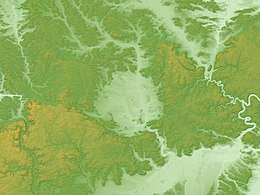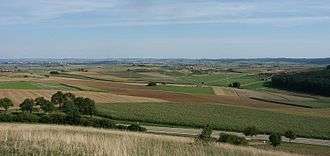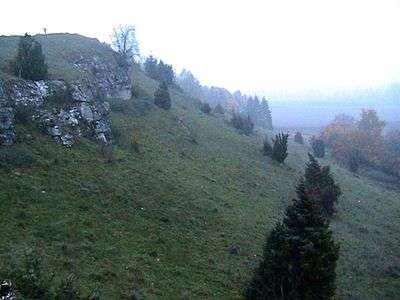Nördlinger Ries
 Relief Map of Nördlinger Ries | |
| Impact crater/structure | |
|---|---|
| Confidence | Confirmed |
| Diameter | 24 km (15 mi) |
| Age |
15.1 ± 0.1 Ma Middle Miocene |
| Exposed | Yes |
| Drilled | Yes |
| Bolide type | Achondrite |
| Location | |
| Coordinates | 48°53′N 10°34′E / 48.883°N 10.567°ECoordinates: 48°53′N 10°34′E / 48.883°N 10.567°E |
| Country |
|
| State | Bavaria |
| District | Donau-Ries |
| Municipality | Nördlingen |
 Location of the crater in Germany | |
The Nördlinger Ries is a large circular depression in western Bavaria, Germany, located north of the Danube in the district of Donau-Ries. The city of Nördlingen is located about 6 kilometers (3.7 mi) southwest of the centre of the depression.
Etymology
"Ries" is derived from Raetia, since the tribe of Raetians lived in the area in pre-Roman times.
Description

The depression is interpreted as a meteorite impact crater formed about 14.3 million–14.5 million years ago in the Miocene.[1][2] The crater is most commonly referred to simply as Ries crater or the Ries. The original crater rim had an estimated diameter of 24 kilometers (15 mi). The present floor of the depression is about 100 to 150 m (330 to 490 ft) below the eroded remains of the rim.
It was originally assumed that the Ries was of volcanic origin. In 1960 Eugene Shoemaker and Edward C. T. Chao showed that the depression was caused by meteorite impact.[3] The key evidence was the presence of coesite, which, in unmetamorphosed rocks, can only be formed by the shock pressures associated with meteorite impact. The coesite was found in the locally derived suevite building stone of the Nördlingen town church.[4] The suevite was formed from mesozoic sediments shocked by the bolide impact.[5][6]
The Ries impact crater was a rampart crater, thus far a unique finding on Earth.[7] Rampart craters are almost exclusively found on Mars. Rampart craters exhibit a fluidized ejecta flow after impact of the meteorite, most simply compared to a bullet fired into mud, with the ejecta resembling a mudflow.
Another impact crater, the much smaller (3.8 km diameter) Steinheim crater,[8] is located about 42 km (26 mi) west-southwest from the centre of Ries. The two craters are believed to have formed nearly simultaneously by the impact of a binary asteroid.
Recent computer modeling of the impact event indicates that the impactors probably had diameters of about 1.5 kilometers (4,900 ft) (Ries) and 150 meters (490 ft) (Steinheim), had a pre-impact separation of some tens of kilometers, and impacted the target area at an angle around 30 to 50 degrees from the surface in a west-southwest to east-northeast direction. The impact velocity is thought to have been about 20 km/s (45,000 mph). The resulting explosion had the power of 1.8 million Hiroshima bombs, an energy of roughly 2.4×1021 joules.
The Ries crater impact event is believed to be the source of moldavite tektites found in Bohemia and Moravia (Czech Republic).[9] The tektite melt originated from a sand-rich surface layer that was ejected to distances up to 450 km (280 mi) downrange of the crater.
Stone buildings in Nördlingen contain millions of tiny diamonds, all less than 0.2 mm (0.0079 in) across. The impact that caused the Nördlinger Ries crater created an estimated 72,000 tonnes (79,000 short tons) of them when it impacted a local graphite deposit. Stone from this area was quarried and used to build the local buildings.[10]
Archaeology
On one edge of the Nördlinger Ries are the Ofnet Caves, where, at the beginning of the 20th century, archaeologists discovered thirty-three human skulls dating to the Mesolithic period.[11]
Gallery
 View from the southwest
View from the southwest- Suevite from the Nördlinger Ries (type locality)
- Typical shatter cone from Wengenhausen, Ries impact crater
 The crater rim near the village of Mönchsdeggingen
The crater rim near the village of Mönchsdeggingen
References
- ↑ "Ries". Earth Impact Database. University of New Brunswick. Retrieved 2017-10-09.
- ↑ Johannes Baier: Zur Herkunft und Bedeutung der Ries-Auswurfprodukte für den Impakt-Mechanismus. - Jber. Mitt. oberrhein. geol. Ver., N. F. 91, 9-29, 2009.
- ↑ E.M. Shoemaker and E.C.T. Chao (1961). New Evidence for the Impact Origin of the Ries Basin, Bavaria, Germany. J. Geophys. Res., 66(10), 3371–3378. doi:10.1029/JZ066i010p03371
- ↑ "Exploring Space: The Quest for Life", 2005, Nova.
- ↑ Johannes Baier: Die Auswurfprodukte des Ries-Impakts, Deutschland, in Documenta Naturae, Vol. 162, München, 2007. ISBN 978-3-86544-162-1; Johannes Baier: Zur Herkunft der Suevit-Grundmasse des Ries-Impakt Kraters, in Documenta Naturae, Vol. 172, Munich, 2008. ISBN 978-3-86544-172-0
- ↑ Johannes Baier: Die Bedeutung von Wasser während der Suevit-Bildung (Ries-Impakt, Deutschland). - Jber. Mitt. oberrhein. geol. Ver., N. F. 94, 55-69, 2012.
- ↑ Sturm, Sebastian; Wulf, Gerwin; Jung, Dietmar; Kenkmann, Thomas (2013). "The Ries impact, a double-layer rampart crater on Earth". Geology. 41: 531–534. Bibcode:2013Geo....41..531S. doi:10.1130/G33934.1.
- ↑ Johannes Baier & Armin Scherzinger: Der neue Geologische Lehrpfad im Steinheimer Impakt-Krater. - Jber. Mitt. oberrhein. geol. Ver, N. F. 92, 9-24, 2010.
- ↑ Günther Graup, Peter Horn, Horst Köhler & Dieter Müller-Sohnius: Source material for moldavites and bentonites. In Naturwissenschaften. Vol. 67, Berlin, 1981.
- ↑ John Emsley (2001). Nature's Building Blocks. Oxford University Press, pp. 99. ISBN 0-19-850341-5.
- ↑ Onians, R. B. (1988). The Origins of European Thought. Cambridge University Press. p. 541. ISBN 0521347947.
External links
| Wikimedia Commons has media related to Nördlinger Ries. |

